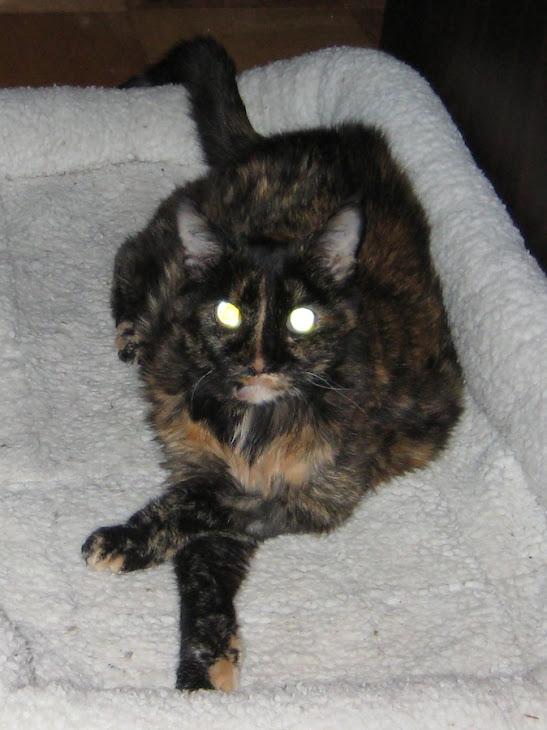 April is Pet First Aid Awareness Month! Are you prepared in case your cat gets injured?
April is Pet First Aid Awareness Month! Are you prepared in case your cat gets injured?This goes far beyond having the right first aid items on hand, although that's an important first step. But it also means knowing what to do and, sometimes, what not to do when something traumatic happens to your little furry baby.
As with most things, preparedness is key. Keep a first aid kit on hand. In the event of a disaster that would require evacuation, make sure you also have an evacuation kit prepared so you can grab it and go quickly. This is something most Floridians think about during hurricane season, but just ask people in Japan how important it is to be prepared for an emergency evacuation at any time of the year.
Knowing what to do is also important. Do you know how to perform CPR on a cat? In the event that your cat has nearly drowned, been electrocuted, gotten hit by a car, or suffered a heart attack, the cat's breathing and heartbeat may have stopped. It's important to keep blood flowing to your cat's brain, as brain tissue starts dying when it's deprived of oxygen for 4 to 5 minutes. Since it would likely take you much longer than this to drive to the nearest vet, knowing how to perform kitty CPR could save your cat's life. So here's how you do it:
- If there is profuse bleeding, especially if bright red blood is spurting from an artery, make sure to stop this first by pressing on the area (preferably with a soft cloth or paper towel you can hold there) or applying a tourniquet. If you don't stop the bleeding, the cat will be losing more blood with every chest compression. Extreme blood loss could lead to shock or even be fatal. Keep pressure on the area as long as the bleeding continues. This may require someone to help you.
- Make sure that the cat is not breathing. Do not perform CPR on a cat that is breathing. If someone else is around, have them phone the vet while you're performing CPR.
- Check the cat's airway to make sure nothing is blocking it:
Remove any type of neckwear the cat is wearing.
Open its mouth and pull the tongue forward.
If there is anything in the mouth or airway, try to remove it with your fingers. - If your cat has fallen into a pool or pond and drowned, pick him up by the back legs and gently swing him back and forth a few times to allow any water to drain out of the airway.
- Lie the cat on its right side, being careful to keep its neck and head straight to maintain an open airway. Its left side should be up, so the heart is not stressed by the cat's body weight lying on it and so that you have better access to it if you need to do chest compressions.
- Place your mouth over the cat's nose and gently blow into it for about 3 seconds. Make sure you're not also covering the cat's mouth. You'll be able to feel any excess air coming out of the mouth and see the chest expanding. If you can't see the chest expanding, lightly cover the cat's mouth and blow a little more strongly.
- Allow the chest to naturally expel the air you have just blown into it; you'll see it going back down from where it had just expanded with your breath.
- Check to see if the cat's heart is beating. You should be able to find a pulse right next to the dew claw pad (sort of like the "thumb" on the cat's paw), in a spot that would correspond to a person's wrist. Feel with your fingers, not your thumb. If you can't find a pulse there, feel inside the rear leg, in the femoral artery area. If there's no pulse there, it's a good bet that the cat's heart has stopped beating.
- If the heart is beating, just repeat the breaths about every 3 to 5 seconds until the cat begins naturally breathing again.
If the heart is not beating, place your thumb on the cat's ribcage, just behind its elbow, with the palm of your hand cupping the chest from underneath the cat. Gently, but firmly, squeeze for about 1/2 second. Repeat this for about 10 compressions, averaging one compression per second. - If the cat is still not breathing, repeat the breath into the nose, alternating with the chest compressions, checking after each to see if the vital signs have returned naturally. Sometimes the heartbeat can return before the breathing, so discontinue the compressions if this happens, but keep up the breathing until the cat begins breathing naturally.
- As soon as your cat is stable, immediately transport it to the vet. Be aware that your cat may be very disoriented once he regains his senses and more prone to scratching or biting as he will be frightened and not understand that you're trying to help him.
Purrs!
Want more information? This book has extensive sections on first aid, home nursing, and homeopathic remedies for your cat.








No comments:
Post a Comment